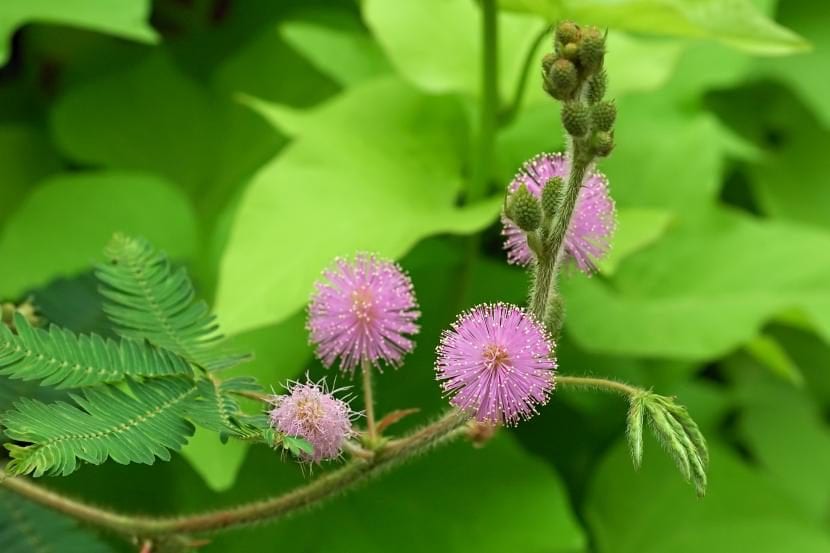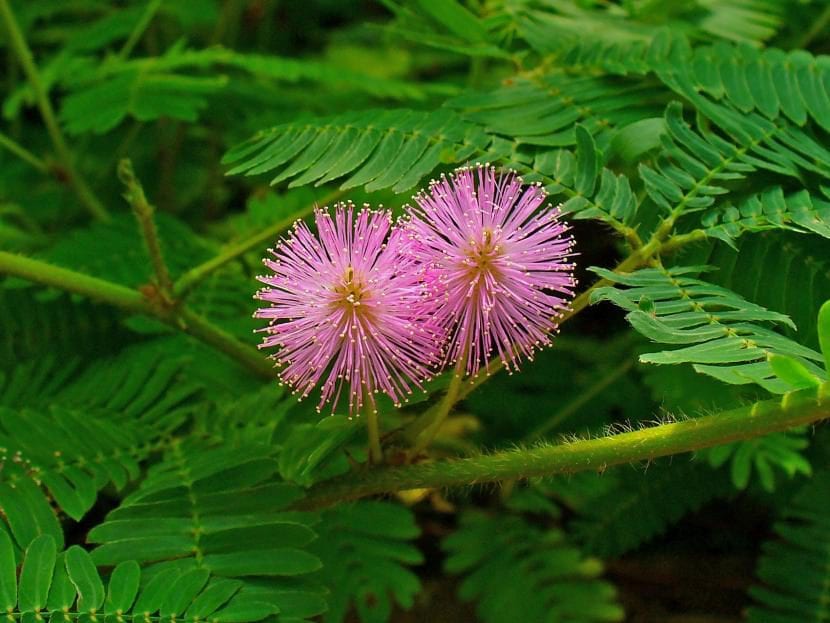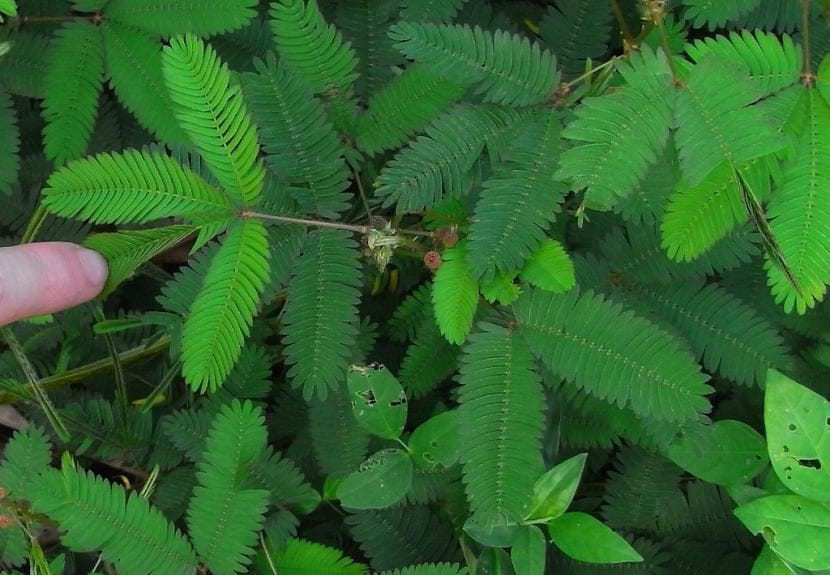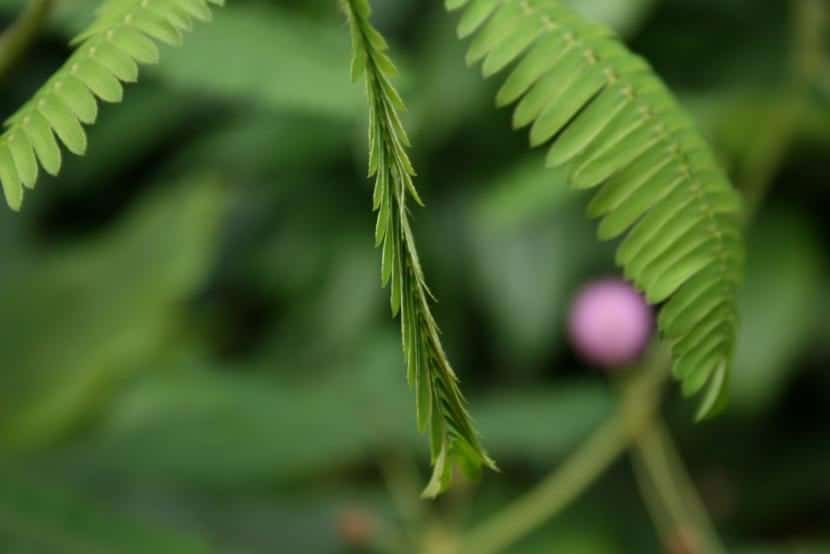
Photographed at the Conservatory of Flowers, San Francisco
If there is a really curious plant that inhabits this dear planet, this is undoubtedly the Mimosa prudish, also known as the Plant of Shame, or the Sensitive Mimosa. It is a herbaceous plant native to Brazil, widely distributed throughout the tropics in which it has been naturalized. In fact, it can be found on both sides of tropical roads coexisting with other native species.
In the rest of the world it behaves as an annual, that is, it germinates, blooms and gives seeds the same year. In winters with frost, it can survive indoors or in a greenhouse, but it is not easy as it is very sensitive to cold. But that does not mean that you cannot enjoy it the rest of the year. Would you like to know what makes it so peculiar and how is it cared for? Don't miss out on this special.
Characteristics of the Mimosa pudica

This extraordinary plant is about 30-35cm tall. It has pinnate leaves, green in color, and very thin stems, less than 0cm in diameter. Its flowers, which appear during the summer, are a very pretty mauve pink, and are shaped like a small pompom. By autumn its seeds, which measure around 0,5cm in diameter and are dark brown in color, will be ripe and ready to germinate.
As in the tropics there are so many threatened, evolution has wanted this plant fold your sheets at the slightest touch; and not only that, but if the insect continues to be deposited on it, the stem will drop. At night, its leaves remain folded. These movements are known as nictinastias, and they are an example of a plant circadian rhythm. They serve above all for defense, but also to avoid losing excessive water during the driest months.
How do you take care of yourself?
This is a plant that is very easy to grow and, if the climate is warm and there is no frost, it can last for several years; in the rest of the world, it is used as a seasonal or indoor plant. Still, regardless of where you have it, I'm going to give you a few tips so that it grows healthy and produces an interesting amount of flowers.
Location
You can place your plant both in full sun and in half shade (that has more light than shade) In the event that you want to have it indoors, put it in a room where a lot of natural light enters, and where it is protected from drafts.
Irrigation
Watering has to be frequent, especially during the warm months. Therefore, I recommend you water it 3-4 times a week in good weather, and every six days the rest of the year. If you have it at home, during the winter it is advisable to space the waterings a little more, watering every 8 days or so, since the earth will take longer to dry.
Subscriber
To get it to survive the winter, apart from growing a lot during the summer 🙂, it is highly recommended to pay from spring to late summer (You can also in autumn if there is no frost in your area). You can use universal compost, or opt for liquid organic fertilizers, such as algae extract or guano. Follow the directions specified on the package.
Transplant

As soon as you acquire the plant, it should be planted in a pot that is 2-3cm wider. Why? Well, it is true that it is a rather small species, but since they have been cultivated in greenhouses, their root system has grown enough to form an important root ball. In doing so, it has been absorbing the nutrients it has needed from the soil, so in order for it to continue growing as well, it is essential to add new soil. This soil can be a universal substrate for plants, compost or black peat mixed with 30% perlite or other similar material.
Mimosa pudica problems
Although it is very resistant to pests and diseases, the truth is that it can also have some other problems. Namely:
- Leaves that turn yellow and fall: it can be due to cold or excess water. In the event that it is cold, I advise you to wrap it with a transparent plastic as a greenhouse, and place it near a heat source.
And if it is due to excess water, check the humidity of the soil and, if it is very humid, remove it from the pot and wrap it with kitchen paper so that it absorbs the water overnight. - Appearance of small white or red balls on the stems: if they go easily with your fingers, they are probably mealybugs. Being small, it can continue to be removed with your fingers, or with the help of a swab from the ears dipped in pharmacy alcohol.
- Tiny insects in flower buds: it is difficult to happen, but if you see insects in the flower buds, it is possible that they are aphids. They are easily removed with any broad spectrum insecticide.
How does it reproduce?

If you want to have more specimens of this beautiful plant, or if you would like to experiment and see if any of them survive the winter in your area, I recommend that get the seeds in spring. You can find them for sale in nurseries and gardening stores, also in online stores. Once you have them, you can - it is not important - put them in a glass of water for 24 hours.
Then You just have to fill a pot with substrate, place a maximum of 2 seeds a little apart, cover them a little ... and water. Well, then we'll have to wait 🙂, but if you keep the soil moist and in an area with lots of light, you will start to see seedlings very, very soon. In fact, when the temperature is above 15ºC, they germinate in the course of 7 or 10 days.
They grow very quickly, so after a month or so they can be moved to larger pots, or peeled and plant each seedling in an individual pot. Don't you know how to do it? Don't worry: let's see how to proceed in each case:
Transplant to a larger pot
To transfer them to a larger pot - it must be about 4 cm more -, you have to extract the plants from what has served them as a seedbed so that the root ball comes out intact. Later, Fill his new pot with some substrate, insert the Mimosas, and then finish filling the pot.
Finally, it will be give it a generous watering, and place them in the bright place that you like the most.
Peal and plant
To ring, you have to do the following:
- Remove the seedlings from the pot.
- Remove as much of the soil attached to the roots as possible.
- Then put the root ball in a bucket of water, and "clean" the roots.
- Now, carefully, you can untangle the roots.
- When they are separated, it is time to fill their pots with substrate.
- Place them each in their new "home" in the center.
- Fill the pots with substrate.
- And water.
After a month or two at the most, they will flower.
What did you think of Mimosa pudica?
Hello my mimosa plant I found it in excess of the air conditioning today it is down, what can I do it?
Hello Ceci.
The first thing is to move it to an area where there are no drafts.
Afterwards, you have to be patient, and water only two or three times a week.
A greeting.
Your article has been very useful to me. I had quite a lot of them, and my cultivation was ruined by mites (spider mites) in the summer. Irrigation also had to be very frequent in Madrid. I recommend large pots so that the plant can last longer without watering.